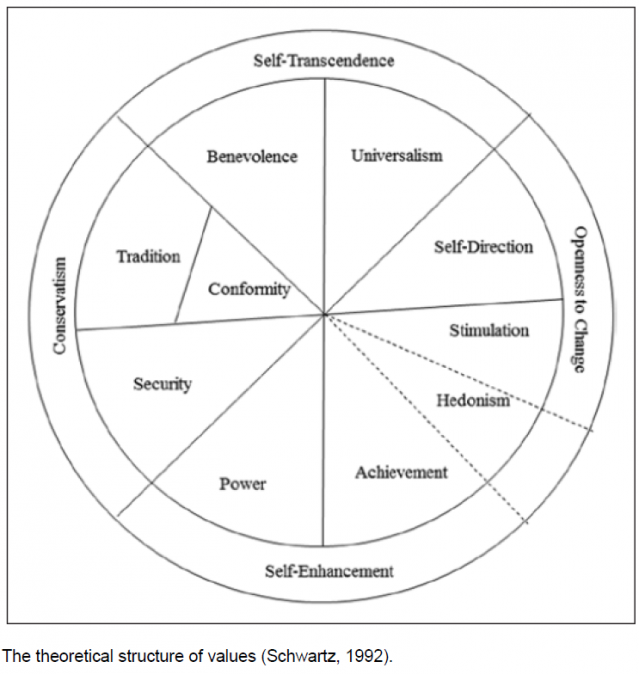Personality
Do Personality Traits and Values Form a Coherent Whole?
Integrating personal values into Life History Theory presents problems
Posted December 11, 2014
A big concern in personality psychology today is how to integrate the different components of the person into a unified theory. Older approaches have tended to focus on understanding particular components rather than the whole person. Trait theories for example have focused on describing relatively stable characteristics of a person such as how they typically think, feel and behave. Theories focusing on personal values on the other hand stress the guiding principles that influence what goals a person regards as important to strive for in life. Recent theories have attempted to understand how both traits and values fit into a broader model of personality, and hence have looked at how particular traits, e.g. those in the Big Five, are related to particular values. An even more ambitious approach to personality called Life History Theory (that I discussed in a previous post) is based on the notion that a whole range of human characteristics, including personality traits, intelligence, sexuality, and even physical and mental health, form a coherent and unitary whole known as the K-factor. An implication of this theory is that there is a general factor of personality that combines all the major traits in a single socially desirable way. Values on the other hand do not lend themselves to being combined in this way, because some values are incompatible with each other. Furthermore, some of the Big Five traits are associated with incompatible values. This suggests that a theory of personality that integrates both traits and values may be incompatible with one that organises personality around a single unitary factor, such as Life History Theory attempts to do.

Merging disparate things into One is not always a good idea
Personality traits can be thought of as qualities that define what a person is like. Traits are fairly stable patterns of thinking, feeling and behaving. Values on the other hand refer to what a person considers to be important and consist of fairly stable global life goals. A currently well accepted trait model proposes that five broad factors of personality subsume the main traits that people have. These are called neuroticism, extraversion, agreeableness, conscientiousness, and openness to experience, all of which are considered to be separate and distinct from each other. One of the most well researched models of personal values is that of Schwartz, which proposes ten broad values based on common motives that people may consider more or less important. Descriptions of the ten values are shown below.

Descriptions of the 10 values according to Schwartz
In this model, values are arranged in a circle based on how they are related, so that values based on complementary motivations neighbour each other, while incompatible values are at opposite sides (Parks-Leduc, Feldman, & Bardi, 2014). The ten values can be grouped along two main axes: openness to change versus conservation, and self-transcendence versus self-enhancement. Openness to change ‘implies the promotion of novelty and autonomy’ as opposed to conservation values that promote stability and social order. Self-enhancement values promote personal interests, as opposed with self-transcendence values which promote the welfare and acceptance of others as equal (Fischer & Boer, 2014).

Although traits and values are not the same things, there are some similarities between them that could lead them to overlap. Specifically, some traits have similar content to certain values, and so people high in particular traits may tend to have related values. For example, the trait of openness to experience to experience is similar in content to openness to change values, the trait of agreeableness is similar in content to self-transcendence values. Indeed, a meta-analysis has found that there are moderate correlations between traits and values. Specifically, openness to experience is positively correlated with openness to change values and negatively correlated with conservation values. Agreeableness is positively correlated with the self-transcendence values (especially benevolence), and negatively correlated with power, one of the self-enhancement values. Looking at additional correlations reveals that while some of the Big Five relate to similar values, not all of the associations between the Big Five and values are compatible with each other. For example, openness to experience and agreeableness are both positively correlated with universalism. On the other hand, agreeableness also has moderate positive correlations with conformity and tradition, and conscientiousness is positively correlated with conformity and security, while openness to experience is negatively correlated with all of these conservation values. Additionally, while extraversion is most particularly correlated with openness to change values, it is also correlated with valuing power, which value has a negative correlation with agreeableness.1
This means that the Big Five traits tend to be associated with a number of incompatible values. That is, people high in agreeableness and conscientiousness will tend to prefer controlling oneself in order to fit in with others, while people high in openness to experience will prefer to express their individuality and autonomy. Additionally, highly extraverted people tend to like being in charge of people and having a lot of material resources, while highly agreeable people tend to be more concerned about the social welfare of other people. Please note that these general statements are based on modest associations between traits and values, so there are plenty of people to whom these generalisations will not necessarily apply. Additionally, the fact that the correlations between traits and values are relatively modest means that although they are related, they are not exactly the same things.
One implication of these findings is that the overall pattern of trait-value associations seems difficult to integrate with the idea that all the features of human personality and functioning can be organised around a single coherent dimension such as the K-factor. One of the claims of Life History theory is that there is a superordinate general factor of personality that combines all of the Big Five traits in a specific socially desirable way (Rushton & Irwing, 2011). That is, a person with high levels of a general factor of personality would be highly extraverted, agreeable, conscientious, emotionally stable (i.e. low in neuroticism) and open to experience. While it is certainly possible for individuals to combine such traits, if this really is a widespread general pattern it is not very clear what set of values would be most compatible with it. Persons who are high in both agreeableness and openness to experience for example might be torn between their desires to fit in with social norms on the one hand, and their desire to express their individuality on the other. People who are both highly extraverted and highly agreeable seem to be faced with choosing between their desire for power and their desire to serve others. In practice, people face these sorts of choices quite often. Life History Theory proposes that evolutionary selection pressures have converged on one over-arching dimension along which personality varies, but I am not sure what sort of value preferences would be most compatible with the proposed K-factor. For example, if someone is high in the K-factor would they be expected to be more conservative or more open to change? Or would they compromise? As I have discussed in previous posts (here and here) I am inclined to think that during evolution there have been a variety of adaptive strategies that humans have developed that have shaped our personality structure. For example, people with “dark side” traits (low K) often tend to be charming and socially skilled (high K) as well (Jonason, Li, & Teicher, 2010). Different strategies involve trade-offs between particular costs and benefits, e.g. being good to oneself (self-enhancement) versus being good to one’s neighbours (self-transcendence). Value preferences involve weighing conflicting priorities against each other and hence there might not one “best” set of values that is optimally adaptive from an evolutionary standpoint. Personality itself has probably evolved like a patchwork of interacting parts rather than a seamless whole.
Footnote
1For the sake of completeness, I will add that neuroticism/emotional stability was not significantly correlated with any of the ten values.
Please consider following me on Facebook, Google Plus, or Twitter.
© Scott McGreal. Please do not reproduce without permission. Brief excerpts may be quoted as long as a link to the original article is provided.
Image Credit
One Ring v3 by vi3x via DeviantArt
Other Posts discussing the General factor of personality
Personality’s “Big One”: Reality or Artifact?
Personality’s Big One Revisited: The Allure of the Dark Side
What Is An Intelligent Personality?
References
Fischer, R., & Boer, D. (2014). Motivational Basis of Personality Traits: A Meta-Analysis of Value-Personality Correlations. Journal of Personality, n/a-n/a. doi: 10.1111/jopy.12125
Jonason, P. K., Li, N. P., & Teicher, E. A. (2010). Who is James Bond? The Dark Triad as an Agentic Social Style. Individual Differences Research, 8(2), 111-120.
Parks-Leduc, L., Feldman, G., & Bardi, A. (2014). Personality Traits and Personal Values: A Meta-Analysis. Personality and Social Psychology Review. doi: 10.1177/1088868314538548
Rushton, J. P., & Irwing, P. (2011). The General Factor of Personality: Normal and Abnormal. In T. Chamorro-Premuzic, S. v. Stumm & A. Furnham (Eds.), The Wiley-Blackwell Handbook of Individual Differences ( First ed.): Blackwell Publishing Ltd.




